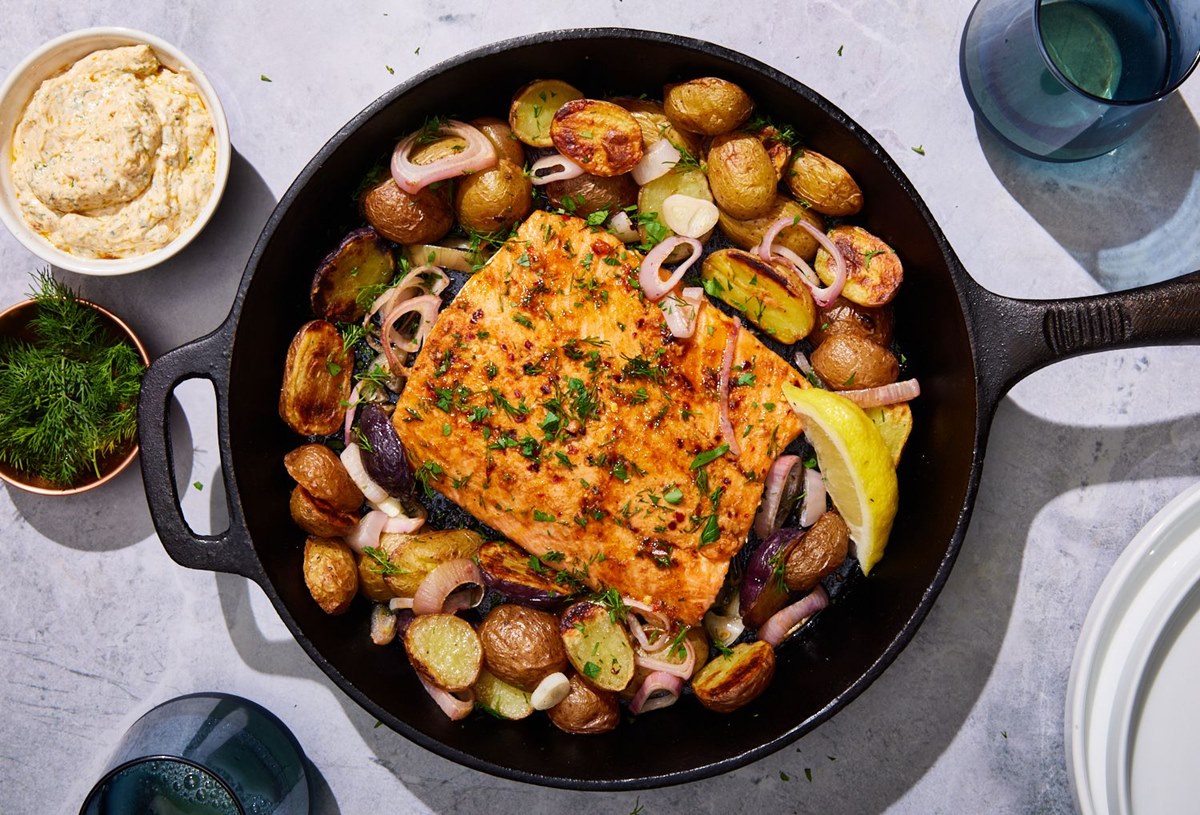Cooking salmon in a cast iron skillet can yield gorgeous, crispy-skinned fillets with tender and flaky meat. With the right technique, it’s easy to achieve restaurant-quality salmon at home. Marinating the fish before cooking infuses it with extra flavor for added appeal. Follow this step-by-step guide to learn how to cook marinated salmon fillets to perfection using a cast iron skillet.
Why Cook Salmon in Cast Iron?
Cast iron skillets provide even heat distribution and retention for perfectly cooked salmon every time. The heavy material sears the exterior to give a lovely brown crust while allowing the interior to cook gently. This results in moist tender salmon that flakes apart nicely. Cast iron also forms a nonstick surface when properly seasoned and preheated.
Salmon fillets are a great choice for cooking in cast iron, The oil-rich fish benefits from direct pan contact and won’t fall apart or stick, You can cook salmon portions quickly over high heat for a weeknight dinner, Large fillets also work when you need to feed a crowd
Tips for Selecting Salmon
The best salmon for cooking in cast iron is wild-caught. Popular sustainable options like sockeye and king have bright pink-orange flesh with rich flavor. Farm-raised Atlantic salmon is widely available but has a less desirable taste.
When buying fresh salmon, look for glossy skin, firm flesh, and a fresh sea smell. Uniform 1-inch thick portions ensure even cooking. Inspect fillets for minimal white fat deposits that can cause splattering during cooking. Purchase sustainably caught salmon when possible.
Making a Flavorful Marinade
A quick marinade adds lots of flavor to salmon before cooking. Whisk together a wet mixture with oil, acid, and seasonings. Popular choices include:
- Soy sauce, brown sugar, garlic, ginger, and lemon
- Balsamic vinegar, Dijon, maple syrup, and garlic
- Olive oil, spices, citrus, and fresh herbs like dill or parsley
Place fillets in a shallow dish and cover with marinade. Let sit for 30 minutes up to 2 hours in the refrigerator, turning occasionally. The fish will take on the flavors while remaining moist.
Preheating Cast Iron Skillet
Properly preheating the cast iron skillet is essential for the best sear on your salmon. Follow these steps:
- Coat cold skillet with canola oil and wipe away excess with a paper towel
- Heat over medium-high heat for 2-3 minutes
- Sprinkle with coarse kosher salt and rub in with a paper towel
- Heat 1 minute until smoking begins
- Carefully add a bit more oil and tilt skillet to coat – this helps the oil penetrate the pan surface
The hot skillet will sizzle and sear the marinated salmon nicely.
Cooking the Salmon
Once your cast iron skillet is ripping hot, carefully add the salmon fillets:
- Place fillets skin-side down. Use tongs to avoid splatter.
- Depending on thickness, sear for 2-3 minutes until deeply golden.
- Flip fillets and cook 2 minutes on reverse side.
- For 1-inch thick fillets, finish in a 400°F oven for 4-5 minutes until done.
Salmon is cooked to a safe 145°F when opaque and flakes apart. Cook times vary based on thickness and doneness preference.
Serving Delicious Cast Iron Salmon
Your perfectly seared and cooked salmon is ready to enjoy! Garnish with lemon wedges, fresh parsley or dill, or a drizzle of extra virgin olive oil.
Delicious sides for salmon cooked in cast iron include:
- Rice pilaf or quinoa
- Sauteed greens like kale or spinach
- Roasted asparagus, broccolini or brussels sprouts
- A fresh green salad
For a quick sauce, simmer extra marinade to kill bacteria before drizzling over salmon.
With the right prep and techniques, you can achieve outstanding restaurant-quality salmon at home using your cast iron skillet. The combination of a flavorful marinade and screaming hot pan creates irresistible fillets with a crispy exterior and moist interior every time.
Tips for Cast Iron Salmon Success
- Pat fish dry before adding to pan
- Use spatula and fish turner instead of tongs
- Preheat oven and stove for even cooking
- Cook skin-side down first for maximum crispness
- Let cast iron cool before cleaning to prevent damage
- Serve salmon right after cooking for optimal texture
With practice, you’ll be able to execute perfect salmon in cast iron for your family. Vary the marinade and side dishes for endless delicious meals. Your friends will think you’re a gourmet chef when you serve up these restaurant-worthy salmon fillets.
Frequently Asked Questions
What oil should I use to cook salmon in cast iron?
Choose a high smoke point neutral oil like avocado, grapeseed, vegetable or canola oil. Avoid olive oil which can burn.
How do I know when the salmon is cooked through?
Check that the thickest portion flakes apart and is opaque. Use a thermometer to test for 145°F internal temperature.
Can I cook a whole salmon steak instead of fillets?
Yes, just increase cooking time by 2-3 minutes per inch of thickness. Sear all sides before finishing in the oven.
What temperature should I cook salmon at?
Preheat cast iron skillet over medium-high heat until water droplets dance and sizzle. Cook at 400°F if transferring to the oven.
Can I use a stainless steel skillet instead of cast iron?
You can, but you won’t get the nice sear that cast iron provides. Ensure the pan is very hot before adding oil and fish.
With this comprehensive guide, you’ll be able to execute perfect crispy salmon in a cast iron skillet every time. The combination of a flavorful marinade and a screaming hot pan yields gorgeous, restaurant-quality results. Wow your family and guests with your culinary skills.

Sabra Guacamole Toast with Mango and Lime
Thick toast topped with Sabra Mango and Lime Veggie Fusion Guacamole. Add grilled mango slices and red pepper flakes for the ultimate guacamole toast.
Egg Bun Sandwiches Three Ways
Discover delicious egg-crafted sandwich recipes â a unique twist on classic favorites. Get creative with egg buns!
